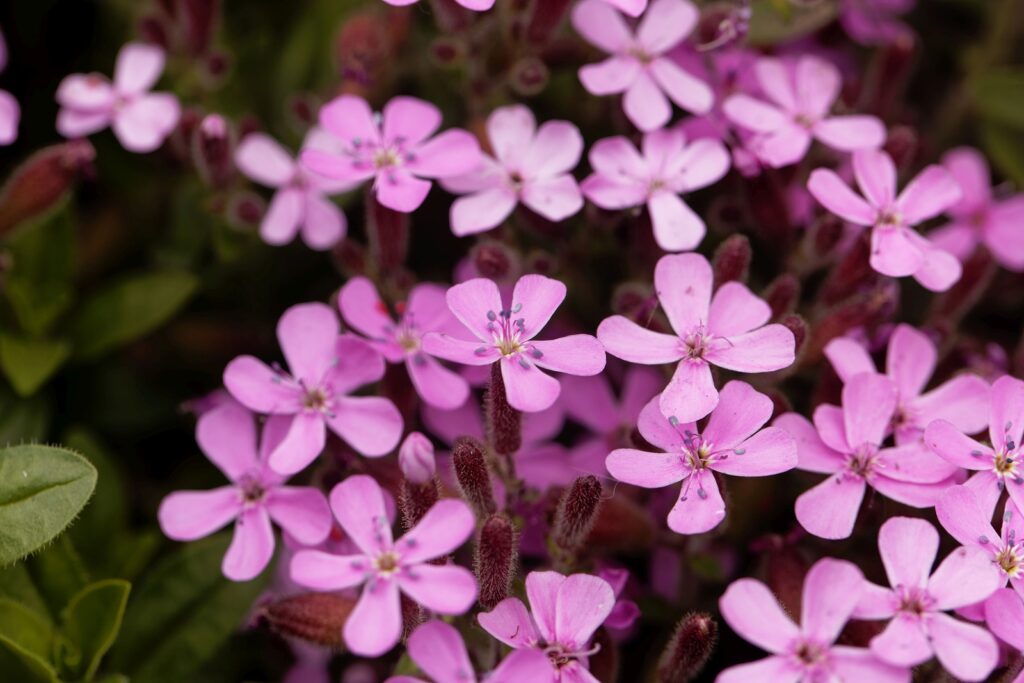Saponaria–commonly called soapwort–is a perennial that bears clusters of five-petaled flowers usually in shades of pink. Saponaria spread readily from fleshy white roots that creep to form broad clumps.
Saponaria includes ground-hugging and taller plants. Compact cultivars are suited for a rock garden, trough, or raised bed. Taller spreading plants can be used in herbaceous or mixed borders.
Saponaria is called soapwort because when vigorously rubbed with water it produces suds.
Saponaria is a genus of 20 species—both annuals and perennials. Saponaria is native from Europe to southwestern Asia. Saponaria is loosely related to Lychnis and Silene.

Get to know Saponaria
- Plant type: Perrenial
- Growing zones and range: Zones 4 to 8
- Hardiness: Hardy to Zone 4; plants do not do well in areas with very hot, humid summers.
- Height and width: 6 to 12 inches (15-30cm) tall and 12 to 28 inches (30-45cm) wide
- Foliage: Narrow leaves are simple and usually lance-shaped.
- Flowers: Clusters of five-petaled clawed flowers usually in shades of pink; flowers are borne in loose or dense heads or panicles
- Bloom time: Summer
- Uses: Include in border or rock garden; will trail across walls
- Common name: Soapwort
- Botanical name: Saponaria
- Family name: Caryophyllaceae
- Origin: Europe to southwestern Asia
Where to plant Saponaria
- Plant Saponaria in full sun.
- Plant Saponaris in moderately fertile, well-drained soil that is from neutral to alkaline pH. Sandy soil is fine; soil too-rich soil causes plants to flop over
When to plant Saponaria
- Set container-grown Saponaria in the garden in spring or autumn.
Planting and spacing Saponaria
- Space Saponaria 12 to 18 inches (30-45cm) apart.
- Saponaria spread readily to form broad clumps because they grow from fleshy white roots that creep and stems sometimes root where they fall over and touch the soil.
How to water and feed Saponaria
- Give Saponaria regular to moderate water.
- Fertilize Saponaria with an all-purpose, slow-release organic fertilizer in spring.
Saponaria care
- Saponaria can be cut back after flowering to maintain compactness.
Saponaria pests and diseases
- Saponaria can be damaged by slugs and snails.

Saponaria propagation
- Plants can be grown from seeds, but double-flowered forms do not come true and must be propagated vegetatively.
- Sow Saponaria seed in containers in an open frame in autumn or spring.
- Dig clumps in spring or fall.
- Propagate Saponaria by rooting cuttings in summer.
Saponaria varieties to grow
- Saponaria x lempergii. Soapwort. A sprawling hybrid perennial that forms ½- to 1-foot-tall clumps that spread to 1½ feet; bears clusters of hot pink 1-inch-wide flowers from midsummer to fall. ‘Max Frei’ trailing plant 6 to 15 inches tall; blue-green foliage; inch-wide, bright reddish pink flowers.
- S. ocymoides. Rock soapwort. Trailing, spreading perennial grows to 1 foot tall and 3 feet wide; oval dark green leaves; bears ½-inch-wide pink flowers in loose bunches shaped much like those of phlox; intolerant of hot, humid summers. ‘Alba’ has a white flower; ‘Rubra Compacta’ has deep pink to red flowers.
- S. officinalis. Soapwort, Bouncing Bet. Grows to 2 feet tall spreads by underground runner; dark green leaves; loose clusters of 1-inch red, pink, or white flowers in midsummer. ‘Rosea Plena’, with double light pink flowers, is the common garden form. ‘Rubra Plena’ has crimson blooms that turn paler as they age.
- S. pumilio (S. pumila). Forms a small, tight, bright green cushion to 1 foot tall and 2 feet wide; large purplish-pink flowers are borne singly on branch ends making a ring of blossoms around the base of the plant.















